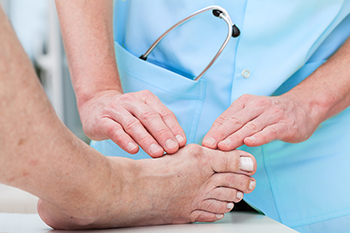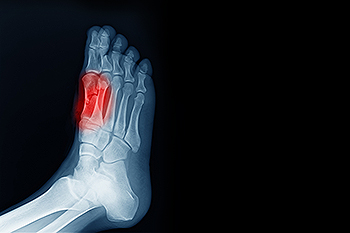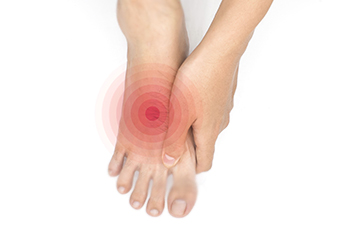August 2023
Types of Bunion Surgery

Bunions, those bony protrusions at the base of the big toe, can escalate from a minor inconvenience to a significant source of pain and discomfort over time. Fortunately, bunion surgery can help to alleviate pain and restore proper alignment of the big toe. Success rates hover around 85%, but perfect alignment and painlessness aren't guaranteed. Reduced joint flexibility, stiffness, and minor foot shortening are potential outcomes. Several surgery types exist, tailored to the severity of the bunion. Osteotomy, a common approach, involves cutting and realigning the bone. Soft tissue realignment may accompany this procedure. Arthrodesis fuses bones in the big toe joint, an option for severe deformities or advanced joint deterioration. Excision arthroplasty removes the bunion and a section of bone, creating a healing false joint. Following surgery, swelling is to be expected for several months. Elevation, crutches, and specially designed shoes will be essential during recovery, which may last approximately six months. If you have a bunion that is impeding you from performing your daily activities, it is suggested that you make an appointment with a podiatrist who can recommend the best treatment options for you.
If you are suffering from bunions, contact Dr. Ronald K. Olm of Grand Traverse Foot & Ankle Center. Our doctor can provide the care you need to keep you pain-free and on your feet.
What Is a Bunion?
A bunion is formed of swollen tissue or an enlargement of boney growth, usually located at the base joint of the toe that connects to the foot. The swelling occurs due to the bones in the big toe shifting inward, which impacts the other toes of the foot. This causes the area around the base of the big toe to become inflamed and painful.
Why Do Bunions Form?
Genetics – Susceptibility to bunions are often hereditary
Stress on the feet – Poorly fitted and uncomfortable footwear that places stress on feet, such as heels, can worsen existing bunions
How Are Bunions Diagnosed?
Doctors often perform two tests – blood tests and x-rays – when trying to diagnose bunions, especially in the early stages of development. Blood tests help determine if the foot pain is being caused by something else, such as arthritis, while x-rays provide a clear picture of your bone structure to your doctor.
How Are Bunions Treated?
- Refrain from wearing heels or similar shoes that cause discomfort
- Select wider shoes that can provide more comfort and reduce pain
- Anti-inflammatory and pain management drugs
- Orthotics or foot inserts
- Surgery
If you have any questions, please feel free to contact one of our offices located in Traverse City and Kalkaska, MI . We offer the newest diagnostic and treatment technologies for all your foot care needs.
Sesamoiditis Symptoms, Causes, and Effective Treatments

Sesamoiditis, a discomforting condition affecting the small sesamoid bones beneath the big toe joint, can significantly impact daily activities. Characterized by pain and inflammation, sesamoiditis typically emerges from repetitive stress or overuse. Symptoms often include a sharp, localized pain beneath the big toe, swelling, and it can be difficult to walk. Wearing high-heeled shoes or thin-soled footwear can exacerbate the issue. Proper diagnosis involves a thorough examination by a podiatrist and often includes having imaging tests performed. Treatment encompasses a range of approaches, including rest, and taking anti-inflammatory medications may help to alleviate pain and reduce swelling. It is beneficial to modify activities and wear appropriate shoes, possibly preventing further stress. In severe cases, immobilization or surgical intervention may be considered. Early recognition and comprehensive care can pave the way to a pain-free and active lifestyle. If you have pain under your big toe, it is strongly suggested that you confer with a podiatrist who can correctly diagnose and treat sesamoiditis.
Sesamoiditis is an unpleasant foot condition characterized by pain in the balls of the feet. If you think you’re struggling with sesamoiditis, contact Dr. Ronald K. Olm of Grand Traverse Foot & Ankle Center. Our doctor will treat your condition thoroughly and effectively.
Sesamoiditis
Sesamoiditis is a condition of the foot that affects the ball of the foot. It is more common in younger people than it is in older people. It can also occur with people who have begun a new exercise program, since their bodies are adjusting to the new physical regimen. Pain may also be caused by the inflammation of tendons surrounding the bones. It is important to seek treatment in its early stages because if you ignore the pain, this condition can lead to more serious problems such as severe irritation and bone fractures.
Causes of Sesamoiditis
- Sudden increase in activity
- Increase in physically strenuous movement without a proper warm up or build up
- Foot structure: those who have smaller, bonier feet or those with a high arch may be more susceptible
Treatment for sesamoiditis is non-invasive and simple. Doctors may recommend a strict rest period where the patient forgoes most physical activity. This will help give the patient time to heal their feet through limited activity. For serious cases, it is best to speak with your doctor to determine a treatment option that will help your specific needs.
If you have any questions please feel free to contact one of our offices located in Traverse City and Kalkaska, MI . We offer the newest diagnostic and treatment technologies for all your foot and ankle needs.
Common Reasons for Big Toe Pain

The foot is a complex structure that contains numerous tendons, ligaments, muscles, and bones, with 19 bones located in the toes themselves. Among the common causes of toe pain are gout, tendonitis, bunions, and osteoarthritis. Rheumatoid arthritis, sesamoiditis, and turf toe are other causes. Gout is a type of arthritis caused by too much uric acid in the system, leading to excruciating big toe pain. Overuse of the big toe, which is instrumental in walking, can lead to inflammation of the big toe joint. Tight-fitting shoes can cause a bump to develop at the base of the big toe, known as a bunion. Pain results from a shift in the biomechanics of the feet and friction caused by shoes. Rheumatoid arthritis can also lead to bunion-like deformities, causing sharp pain. Trauma to the big toe can also trigger osteoarthritis, which is characterized by excessive wear and tear of the toe joints. Sesamoiditis is an inflammation of the tissue surrounding the two tiny sesamoid bones, located at the base of the big toe. Turf toe, an overstretching of the ligament at the base of the big toe. For assistance with big toe pain that is limiting your daily activities, it is suggested that you make an appointment with a podiatrist.
Toe pain can disrupt your daily activities. If you have any concerns, contact Dr. Ronald K. Olm of Grand Traverse Foot & Ankle Center. Our doctor can provide the care you need to keep you pain-free and on your feet.
What Causes Toe Pain?
Most severe toe pain is caused due to a sports injury, trauma from dropping something heavy on the toe, or bumping into something rigid. Other problems can develop over time for various reasons.
Toe pain can be caused by one or more ailments. The most common include:
- Trauma
- Sports injury
- Wearing shoes that are too tight
- Arthritis
- Gout
- Corns and calluses
- Hammertoe
- Bunions
- Blisters
- Ingrown toenails
- Sprains
- Fractures (broken bones)
- Dislocations
When to See a Podiatrist
- Severe pain
- Persistent pain that lasts more than a week
- Signs of infection
- Continued swelling
- Pain that prevents walking
Diagnosis
In many cases the cause of toe pain is obvious, but in others, a podiatrist may want to use more advanced methods to determine the problem. These can range from simple visual inspections and sensation tests to X-rays and MRI scans. Prior medical history, family medical history, and any recent physical traumatic events will all be taken into consideration for a proper diagnosis.
Treatment
Treatments for toe pain and injuries vary and may include shoe inserts, padding, taping, medicines, injections, and in some cases, surgery. If you believe that you have broken a toe, please see a podiatrist as soon as possible.
If you have any questions please feel free to contact one of our offices located in Traverse City and Kalkaska, MI . We offer the newest diagnostic tools and technology to treat your foot and ankle needs.
Foot Massage Techniques and Benefits

Foot massages offer a relaxing and therapeutic way to alleviate sore feet and muscle aches and unwind after a tiring day. There are several effective techniques that can be easily practiced at home, such as arch rubs, toe bends, and pressure points. Each technique targets specific areas of the foot, providing flexibility, tension relief, and improved circulation. Arch rubs involve massaging the underside of the foot, from the heel to the ball of the foot, to soothe strained arches and promote overall foot health. Toe bends are done by holding the heel with one hand and bending all the toes on one foot back and forth at the same time with the other hand. Pressing points on the instep of the foot is another relaxing foot massage technique that uses one hand to support the top of the foot and the thumb on the other hand to press and release the top of the instep, and gradually moving down the instep and back up to the heel in this manner. The toe bends help increase foot flexibility, while pressure points focus on specific areas to release built-up tension and restore balance. Incorporating foot massages into your regular self-care routine can yield remarkable benefits. Beyond soothing your feet, these techniques can lead to reduced pain, improved sleep, and enhanced emotional well-being. By taking time to care for your feet through foot massages, you can experience a holistic improvement in your overall health and relaxation levels. If you would like more information on foot massage techniques, it is suggested that you make an appointment with a podiatrist who can provide you with this information.
Foot therapy is often necessary for those recovering from either foot deformities or foot injuries. If you have concerns regarding therapy, consult with Dr. Ronald K. Olm from Grand Traverse Foot & Ankle Center. Our doctor can provide the care you need to keep you pain-free and on your feet.
Most Common Injuries
People who are active or athletes are prone to a variety of injuries. Therefore, it is often important to take part in physical therapy in order to quickly get back on the right track.
What to Do When Injured
Physical Therapy – This specialized treatment will focus on the affected area, speeding up recovery and the overall healing process. It is a proven method that has helped millions of people return from any injury.
During physical therapy you will undergo regimented training to get back into full form. Training is often very difficult, especially at first when the foot feels weak. Physical therapy often involves:
Basic stretching and twisting exercises – getting the feet’s mobility and flexibility up.
Massaging – the therapist will massage the injured area in order to activate the muscles and relax them.
Strengthening Exercises – this allows the muscles in the affected area to regain their full strength, a vital step towards full recovery.
If you have any questions please feel free to contact one of our offices located in Traverse City and Kalkaska, MI . We offer the newest diagnostic tools and technology to treat your foot and ankle needs.
Do Your Child's Feet Hurt?
Simple Steps That Can Help Diabetic Patients

Many diabetic patients realize the importance of maintaining proper foot care. This can be an overwhelming task to accomplish, and it is beneficial that small steps are taken that can simplify the process. It is important to engage in a gentle exercise program frequently, and this can help to improve blood circulation to the feet, as well as the overall body. Eating healthy foods that can comprise a healthy diet may help to monitor glucose levels, and existing nerve damage may be controlled. Stress can raise blood pressure, and elevating the feet at the end of the day may give them a needed rest and may help to reduce existing stress. Additionally, inspecting the feet daily can reveal any cuts and scrapes that have developed. Many people who are diabetic experience neuropathy, which is the inability to feel sensation in the feet. Family members or caregivers may help patients to see the soles of their feet by helping them to use a mirror. If you have diabetes, it is strongly suggested that you are under the care of a podiatrist who can help you to manage this condition.
Diabetic foot care is important in preventing foot ailments such as ulcers. If you are suffering from diabetes or have any other concerns about your feet, contact Dr. Ronald K. Olm from Grand Traverse Foot & Ankle Center. Our doctor can provide the care you need to keep you pain-free and on your feet.
Diabetic Foot Care
Diabetes affects millions of people every year. The condition can damage blood vessels in many parts of the body, especially the feet. Because of this, taking care of your feet is essential if you have diabetes, and having a podiatrist help monitor your foot health is highly recommended.
The Importance of Caring for Your Feet
- Routinely inspect your feet for bruises or sores.
- Wear socks that fit your feet comfortably.
- Wear comfortable shoes that provide adequate support.
Patients with diabetes should have their doctor monitor their blood levels, as blood sugar levels play such a huge role in diabetic care. Monitoring these levels on a regular basis is highly advised.
It is always best to inform your healthcare professional of any concerns you may have regarding your feet, especially for diabetic patients. Early treatment and routine foot examinations are keys to maintaining proper health, especially because severe complications can arise if proper treatment is not applied.
If you have any questions please feel free to contact one of our offices located in Traverse City and Kalkaska, MI . We offer the newest diagnostic and treatment technologies for all your foot and ankle needs.






